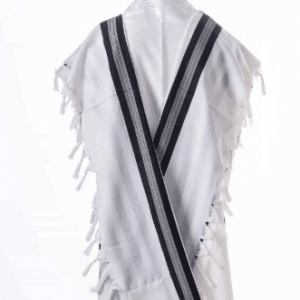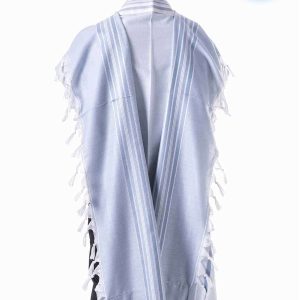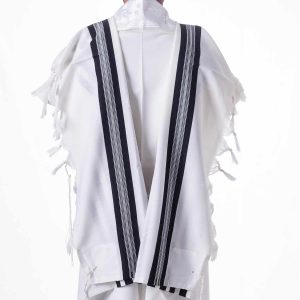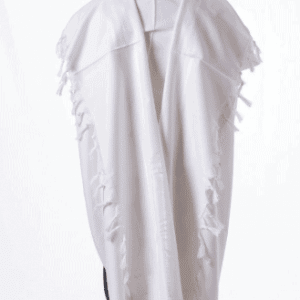No products in the cart.
Tallit Gadol
-
Beit Yosef Tallit – 100% Wool Tallit (Sephardi)
 Beit Yosef Tallit made of 100% wool.
Beit Yosef Tallit made of 100% wool.- stain-repellent
- Anti-slip
- The prayer shawl comes without thread and can be added to add hand-made threads, plus price.
- Shatnez tested
- Kosher by Badatz Beit Yosef – Sephardic
$93.00 – $171.00Beit Yosef Tallit – 100% Wool Tallit (Sephardi)
$93.00 – $171.00 -
Chabad Tallit [The original] Lubavitch Tallit
 Shatnez tested
Shatnez tested- 100% Fine Wool
- Silk corners as Chabad custom
$123.00 – $155.00Chabad Tallit [The original] Lubavitch Tallit
$123.00 – $155.00 -
Gartel – Straight
Gartel- Thickness 4-12 threads – straight – a fine and delicate twist, unbreakable ferns
The Gartel length: 3.6 meters / 141.7″
$5.00 – $13.00Gartel – Straight
$5.00 – $13.00 -
Light luxury tallit “Pe`er” – black
A unique woolen Tallit with liquid-repellent material, coated with a microscopic coating, which delivers excellent wrapping to stain liquid stains alone.
The Tallit is woven in delicate slots to prevent slipping and stability on the shoulders.
The tallit comes without threads, but you can add and tying handmade threads on the Tallit, in Mehudar supervision, at an extra price.
$110.00 – $166.00Light luxury tallit “Pe`er” – black
$110.00 – $166.00 -
Tallit – Blue & Gold Stripes (Wool) – Jerusalem Tallit
 Shatnez tested
Shatnez tested- 100% Fine Wool
- kosher
- Made in Israel
- Made in Israel by Mishkan Hatchelet
$58.00 – $107.00Tallit – Blue & Gold Stripes (Wool) – Jerusalem Tallit
$58.00 – $107.00 -
Tallit “Bnei Or” – Rainbow
 Tallit Bnei Or – Rainbow Tallit
Tallit Bnei Or – Rainbow Tallit- Shatnez tested
- 100% Fine Wool
- kosher
- Made in Israel
- Made by Mishkan Hatchelet
- The Tallit comes with thin machine-spun threads and can be added HandSpun threads, plus price.
$77.00 – $133.00Tallit “Bnei Or” – Rainbow
$77.00 – $133.00 -
Tallit “Gvanim” – Tallit with Blue stripes for Wedding
- Shatnez tested
- 100% Fine Wool
- Made in Israel
- Made by Mishkan Hatchelet
- The Tallit comes with thin machine-spun threads and can be added HandSpun threads, plus price.
$92.00 – $132.00Tallit “Gvanim” – Tallit with Blue stripes for Wedding
$92.00 – $132.00 -
Tallit “Sapir” – with Blue stripesTallit

- Anti-slip
- Shatnez tested
- 100% Fine Wool
- kosher
- Made in Israel
- The Tallit comes with thin machine-spun threads and can be added HandSpun threads, plus price.
$83.00 – $121.00Tallit “Sapir” – with Blue stripesTallit
$83.00 – $121.00 -
Tallit “Tashbetz” Gray-Black-Silver
-
- Shatnez tested
- 100% Fine Wool
- Made in Israel
- Made by Mishkan Hatchelet
- The Tallit comes with thin machine-spun threads and can be added HandSpun threads, plus price.
$80.00 – $118.00Tallit “Tashbetz” Gray-Black-Silver
$80.00 – $118.00 -
-
Tallit Bareket – Blue, Light Blue and Silver Stripes
 Shatnez tested
Shatnez tested- 100% Fine Wool
- kosher
- Made in Israel
- Made by Mishkan Hatchelet
- The Tallit comes with thin machine-spun threads and can be added HandSpun threads, plus price.
$85.00 – $119.00Tallit Bareket – Blue, Light Blue and Silver Stripes
$85.00 – $119.00 -
Tallit Gadol “Bnei Or” – Blue stripes
- The Tallit comes with thin machine-spun threads and can be added HandSpun threads, plus price.
- Shatnez tested
- 100% Fine Wool
- Kosher
$87.00 – $133.00Tallit Gadol “Bnei Or” – Blue stripes
$87.00 – $133.00 -
Tallit with Blue Stripes (Wool)
 Shatnez tested
Shatnez tested- 100% Fine Wool
- kosher
- Made in Israel
- Made in Israel by Mishkan Hatchelet
$52.00 – $127.00Tallit with Blue Stripes (Wool)
$52.00 – $127.00 -
Traditional Tallit with Black Stripes – Wool
 Shatnez tested – 100% Fine Wool
Shatnez tested – 100% Fine Wool- kosher
- Made in Israel
- Made by Mishkan Hatchelet
$53.00 – $127.00Traditional Tallit with Black Stripes – Wool
$53.00 – $127.00 -
White Tallit “Tasbetz”
A unique weave of non-slip wool squares that gives a light feel.
In a natural white shade, combined with traditional white stripes. A magnificent ornament with leaves and corners decorated with a brilliant white shade.
The Tallit comes with Mehudar double threads made of machine work. Tying as Ashkenazi custom, under the supervision of Rabbi Aryeh Levin Shlita.
Tallit Mehudar from 100% Fine wool
$98.00 – $138.00White Tallit “Tasbetz”
$98.00 – $138.00 -
Yemenite Tallit (Traditional) with Netted decorate
 Yemenite tallit, decorated in the Yemenite style With ties in the shape of a net on the sides of the Tallit The corners decorated in Yemenite style with silver lines
Yemenite tallit, decorated in the Yemenite style With ties in the shape of a net on the sides of the Tallit The corners decorated in Yemenite style with silver lines- Shatnez tested
- 100% Fine Wool
- Kosher – With the approval of “Yoreh De’ah” – Rabbi Mahfod Shlit“a
- The Tallit does not come with Tzitzits
$109.00 – $196.00Yemenite Tallit (Traditional) with Netted decorate
$109.00 – $196.00
A tallit (also spelled tallis or talit) is a traditional Jewish garment worn during morning prayers and other religious ceremonies. It is a rectangular garment made of wool, cotton, or silk, and it is worn over the shoulders like a shawl. The tallit has special fringes, or tzitzit, on each of its four corners, which are believed to be a reminder of the commandments of God.
The tallit is worn by Jewish men and, in some communities, by women as well (which is forbidden according to the Halacha). It is traditionally worn during morning prayers and other religious ceremonies, such as a bar mitzvah or a wedding. Some Jews also wear the tallit during the week as a sign of devotion and piety. The tallit is an important part of Jewish tradition and is considered a symbol of faith and devotion.
The Tallit: A Symbol of Jewish Faith and Tradition
The tallit, also known as a prayer shawl, is an important symbol of Jewish faith and tradition. Worn by observant Jews during morning prayers, the tallit is a reminder of the commandments and the connection to God.
The History of the Tallit
The tallit has a long history in Jewish tradition, dating back to biblical times. In the book of Numbers, God commands the Israelites to make fringes, known as tzitzit, on the corners of their garments as a reminder of the commandments.
Over time, the tallit evolved from a simple garment with tzitzit on the corners to a more elaborate prayer shawl, adorned with intricate designs and embroidery. In the Middle Ages, the tallit became a symbol of status and wealth, with wealthy individuals commissioning tallitot with expensive materials and intricate designs.
The Significance of the Tallit
The tallit is more than just a garment; it is a symbol of Jewish identity and faith. Wearing a tallit during morning prayers serves as a reminder of the commandments and the connection to God. The tzitzit, or fringes, on the corners of the tallit serve as a reminder to observe the commandments and to lead a righteous life.
The tallit also serves as a symbol of unity among the Jewish people. During the prayer service, the tallit is worn by men and women alike, creating a sense of unity and community among the congregants.
The Tallit in Modern Times
Today, the tallit continues to be an important symbol of Jewish faith and tradition. Many synagogues and Jewish organizations commission custom tallitot with unique designs, making them a popular choice for Bar Mitzvahs, weddings, and other special occasions.
In addition to traditional tallitot, many contemporary designs and materials are also available, such as tallitot made from organic cotton or other sustainable materials.
Tallit Gadol
The prayer for donning a tallit, or Tallit gadol, covers the tzitzit. This prayer is used before the phylacteries. The prayer is Baruch Atah Adonai Eloheynu Melech ha’olam. The prayer book specifies the proper time to hold the fringes of the tallit. Tallits can be made of silk, wool, or rayon.
Wearing a tallit
Jewish men must wear a tallit gadol for morning prayers, although women are not required to do so. The Torah forbids women from wearing men’s clothing, and so tallits can be found in a variety of feminine colors. The stripes on the traditional tallit are black, white, and purple, but a modern tallit can be any color of the rainbow. A tallit is traditionally made of wool but can be made of cotton, silk, or other materials. The only rule for the material used is that it should not violate the prohibition of mixing linen and wool.
The tallit is a symbolic garment for Jews and is mentioned several times in the Bible. The Torah states that God commanded Moses to have his people wear tallits. This is a symbol of their devotion to God and the commandments. This garment also serves as a symbol of the Jewish people’s difference from the local population. Jewish people have used clothing to separate themselves from others, and this has often led to conflicts and violence.
A tallit is a prayer shawl that covers the body. It is made of wool and has tzitzit tassels on the edges. Tallit Gadol can be large and cover the entire body, or they can be small and worn as underwear. Tallits gadol is traditionally worn by men in Ashkenazi communities and by all men over the age of bar mitzvah. However, in Conservative communities, women wear them.
The tallit has become a halachic custom for Jews. It is customary to wear a tallit and cover the head, and the halacha of our ancestors has equal weight to Torah laws. A tallit gadol should be worn all the time, not only when prayer is being conducted. The tallit is worn during Yom Kippur, and the chazzan wears it during the morning prayers.
It is important to avoid sitting on the tzitzit while wearing a tallit gadol. When sitting on a chair, the tzitzit should be on the sides. A tallit gadol can cause the tzitzit to catch on a chair or leg, and you need to move the tzitzit away from the legs while sitting.
Meaning of the Hebrew blessing for donning a tallit
The Hebrew blessing for donning a tallit gadol is often misunderstood. Although anyone can use it at the synagogue, this blessing is most commonly used during morning services. The tallit gadol is not meant for wearing to the bathroom. When someone borrows a Tallit gadol, they should first “give” the tallit to them, then “take” it back.
A tallit gadol is a Jewish head covering that is typically worn from the age of bar mitzvah or pre-school. In many Ashkenazi communities, however, it is only worn after marriage. It may be given to the groom before the wedding as a wedding present or even part of the dowry. The Hebrew word for tallit is Tallit, and the plural of Tallit is talisim.
The Hebrew blessing for donning a tallit gadol is the same as the one for wearing a tallit. It is pronounced “Baruch Ata Adonai Eloheinu,” which means “may the Lord protect you and keep you from harm.” It is a prayer of thanksgiving to the God of all creation. This blessing is an important part of the Jewish ritual.
A Tallit gadol is a large white cloth without a hole, designed to be worn during the morning prayers. During the Shema, the Tallit is mentioned. When the Tallit is worn during the morning prayers, the Tzitzit is said. This prayer is said during the focal point of the prayer, the Shema.
This prayer is said during morning prayers for the purpose of reminding the wearer to observe the commandments of the Torah. The tallit is adorned with fringes on four sides. These fringes are used to remind the wearer to conduct themselves in accordance with the Torah. They are also used during special occasions, such as weddings and birthdays. The prayer shawl is worn over outer clothing.
The Sheheheyanu prayer is said every day except Shabbat. It is also said during the first night of Hanukkah and on holidays. In addition, this prayer is recited on a new dress or when eating a rare fruit. It also serves as a blessing for the wearer. It is also said at the beginning of the day when a person enters a synagogue.
Size of a Tallit gadol
The tallit gadol is a traditional garment worn by Jewish men during morning prayers. The hazzan or reader of Torah wears this garment and it is customary for all functionaries of the prayer service to wear one as well. The tallit gadol is traditionally white with black stripes. Blue stripes are no longer customary but are used as a reminder of God and the sky.
A tallit gadol is usually large and covers most of the body. It is usually around 6 feet long and four feet wide. It is traditionally worn by men and is a distinguishing feature of Jewish life. During services, men wear the tallit gadol in Ashkenazi communities, and all men who have reached bar mitzvah age. However, women can wear a tallit gadol in Conservative synagogues.
The size of a Tallit gadol varies from synagogue to synagogue, but all are suitable for the ceremony. When used correctly, the Tallit gadol can be used by any congregation member at the start of shacharit and Amida. The Tallit gadol is a valuable piece of Jewish clothing and is used by many congregations.
The size of a tallit gadol can be influenced by several factors. First of all, the tallit gadol must be large enough to cover the body. It should be comfortable to wear and cover the shoulders and the upper body. It should also be large enough to cover the arms and the head. A large tallit gadol should be comfortable to wear and should not restrict movement.
Cost of a talit gadol
The Tallit Gadol is a large white shawl without a hole. It is intended to be worn during morning prayers. It is often referred to as a prayer shawl. Its use is mentioned in the Shema, which is the focal point of the prayer. It is commonly used by men and is a customary gift for a Jewish man.
Jewish men wear tallit gadol during prayer. It is a traditional piece of Jewish clothing that dates back to Biblical times. The prayer shawl has many different applications and interpretations, but it serves an essential function in the life of a Jew. The tallit is usually made of cotton or wool. Its cost depends on its size, design, and materials. Tallit Gadol is traditionally worn during morning and Yom Kippur prayers.
The more expensive the fabric, the better the quality of the tallit. This explains the higher price tag. High-quality tefillin are handmade in Israel and made by experienced rabbis with decades of experience in the tefillin production industry. These rabbis hand-pick qualified sofrim to write the kosher parchments, and the scribes are responsible for making the tallit kosher on the inside and out.
Tallit Gadol is an expensive item in the Jewish religion. They can cost anywhere from $50 to $1,000. However, if you want to get the very best one, you should invest in it as soon as possible. There are a number of different brands of tallit gadol on the market, and each one is made to the exact specifications of the person who wants to wear it.
Tallit Size Chart
matching the size of the tallit and the height of the person
| feet (height) | Cm (height) | Inch (height) | |
|---|---|---|---|
| XXS/45 | 4-5ft | 120-140cm | 47”-54” |
| XS/50 | 5ft | 150cm | 59” |
| S/55 | 5.2ft-5.5ft | 160cm-170cm | 62”-67” |
| M/60 | 6ft | 170-185cm | 71” |
| L/65 | 6.3ft | 195cm | 77” |
| XL/70 | 6.3ft+ | 195cm+ | 77″+ |
The measurements – by Mishkan Hatchelet
We recommend that you first take body measurements before purchasing the tallit. You can find the perfect size in the chart, above.
tallit prayer
בָּרוּךְ אַתָּה יְיָ אֱלֹהֵינוּ מֶלֶךְ הָעוֹלָם, אֲשֶׁר קִדְּשָׁנוּ בְּמִצְווֹתָיו וְצִוָּנוּ לְהִתְעַטֵּף בַּצִּיצִית:
Can a woman wear a tallit?
According to Jewish law, women are not obliged to wear a prayer shawl.















